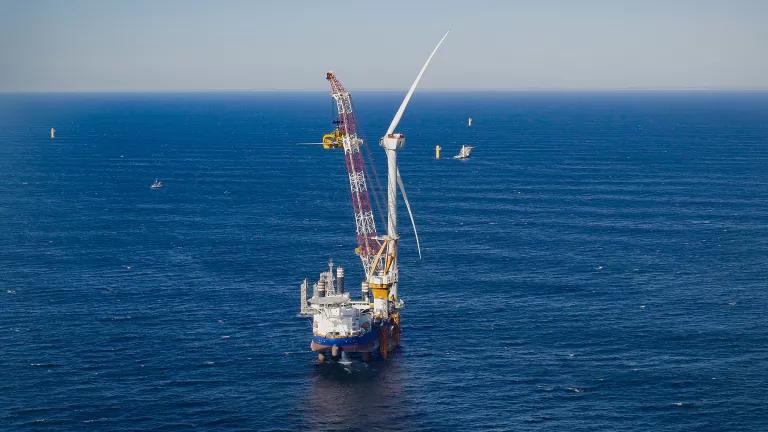Celebrating New York’s First Offshore Wind Project
New York Governor Kathy Hochul and U.S. Department of the Interior Secretary Deb Haaland commemorate the completion of South Fork Wind.

Turbines at South Fork Wind under construction off the coast of Long Island, New York
South Fork Wind
I was honored to join New York Governor Kathy Hochul and U.S. Department of the Interior Secretary Deb Haaland today—together with labor, community, and environmental partners—to celebrate the completion of New York’s first offshore wind project, South Fork Wind, located 35 miles off Montauk, New York, on Long Island’s East End. This is the third offshore wind project to be built in U.S. waters and the first utility-scale project.
This is a significant milestone for New York and the United States. With 12 turbines and a capacity of 132 megawatts (MW), South Fork Wind can supply electricity to approximately 70,000 Long Island homes, reducing carbon emissions by up to six million tons annually—the equivalent of removing 60,000 cars from the road. Building the project employed 1,000 short- and long-term workers. South Fork Wind’s original developers, Orsted and Eversource, entered into a $29 million community benefit agreement with East Hampton Town, New York, where the project’s transmission cable connects to land. The developers also worked with NRDC and other partners on important protections for the endangered North Atlantic right whale during construction. Providing benefits for climate, labor, public health, and communities is essential for building a sustainable U.S. offshore wind industry. NRDC is proud to have helped move South Fork Wind forward.
New York’s ambitious plans for offshore wind are just getting started with South Fork. Last week, Governor Hochul announced that the state had awarded new contracts for two offshore wind projects as part of a rebidding process: Empire Wind 1 and Sunrise Wind. This announcement provides a much-needed jolt of momentum to the burgeoning U.S. offshore industry, as well as to New York’s efforts to achieve its ambitious clean energy targets. The benefits that these new projects will bring to the state are immense. A successful offshore wind industry will lead to the localization of clean energy manufacturing, revitalizing New York’s ports and harbors. It will also provide opportunities for training and deploying skilled union workers, while improving air quality in environmental justice communities. Additionally, it will entail robust protections for the ocean environment and wildlife.
The Biden administration is a key partner with New York and other states in launching sustainable offshore wind power, and projects are moving forward across the United States. The next U.S. offshore wind project, Vineyard Wind 1, located in federal waters off Massachusetts, will be completed by the end of this year. This 62-turbine project has the capacity to deliver 800 MW of clean power. In total, more than seven gigawatts of offshore wind projects, contracted to supply power to seven states, are anticipated to be constructed and operational within the next three years.
These positive developments follow a difficult year for the offshore wind industry. Planned projects in New York and other states faced difficulties due to inflation and supply chain issues, which resulted in higher projected construction costs. A number of projects were canceled. This was a setback, but New York is rebounding.
Becoming a global climate and clean energy leader takes courage and tenacity. With sustained political will from Governor Hochul, smart and expedient implementation by the state’s key agencies, and a strong tailwind from the historic Inflation Reduction Act to incentivize renewables at the federal level, the Empire State can stay on track to meet its ambitious offshore wind goal of deploying 9,000 MW by 2035. This abundant resource will also play a vital part in achieving the state’s broader targets of 70 percent renewable energy by 2030 and zero-emission power sector by 2040. We simply can’t get there without it. South Fork’s completion is a critical milestone on New York’s ongoing journey to a cleaner and brighter future—one that the nation can look to as an example of true climate leadership.




